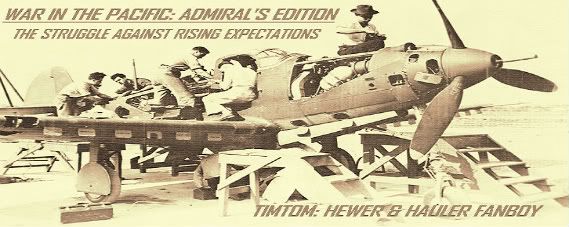At what point do you say enough detail is enough?
It really depends on what you want the game to look and feel like, and the degree to which you want it to be "like WW2." For me, it's detailed enough if it's got operational planning, and the combat model consistently generates "WW2 like" results, at about the same times as in WW2, but not necessarily in the same places (because, as a consim and a game, it presumes that the players might plan different operations than the ones executed in the real war, or initiate them at different times than in the real war).
I DO think you know you have too much detail if you are adding details to the model when you can't truth those details against something tangible and measurable in the real war. Thus my general loathing of "EXP" anyhow. I used to regard it as a kind of "hold your nose abstraction" in GGPW. Now I just think it's a made up number with no bearing on anything at all. To a degree, I think the values assigned to the various a.c. stats in WitP are the same sort of thing, although they sometimes at least get the relative rank order of different a.c. correct, with respect to speed or durability.
How many places to the right of the decimal point is appropriate in a game like this?
That really depends on how sensitive the combat alogorithm is to the number of decimal places. I suspect one could create a good combat alorithm with a simple numeric rank order of quality. Pilots: 0-bad, 1, 2, 3, 4, 5-best; planes 0-bad, 1,2,3,4,5- best. But that'd be a different game. I liked all that excessive detail in GGPW, 'though regarding it as flawed, found it both annoying and flawed in UV, and excessive (probably because of the larger scale of the game), annoying, and "retaining the same tradition of flaws" in WitP that it had in UV.
There are people here on this forum, long-time players who'd tell you that they don't even want individual pilots.
I'd agree with them.
I happen to also think that EXP SHOULD play a major role as a variable in the A2A routine,
I might agree if "whatever EXP is supposed to be" could be objectively tied to any suite of thingies in the real world. How does the Japanese use of an (inferior) three-plane section, their disdain for radios, or their tendency NOT to fly mutual support factor into "EXP?"
I haven't seen anyone say that USN fighter pilots were inferior to Japanese.
Heh. Wait around a bit. And if "EXP" is a substitute for "General Pilot Ability As An Abstraction of Personal Characteristics, Training, Doctrine, and Combat Experience" then the generally higher Japanese EXP ratings in WitP at-start seems to imply an assumption that the Japanese were better pilots.
it just means that the lowest common denominator when he reached the fleet was better at it in the USN.
Well, then, by WW2 "in real life" results, one would have to conclude with all those slightly inferior lowest-common-denominator types in the USN, then the USN's "highest common denominator" types should have been somewhat better than the Japanese. Otherwise, how come the Japanese didn't dominate versus the USN?
Now the Army Air Corps in 42'? That's a different story.
I'm not certain that is correct. It used to be said by my unesteemed opfor here that the Japanese pilots were simply better than USN ones. Now, at least, in their desperation, they accuse me of claiming that American pilots were vastly better than Japanese (largely because they can't defend against the arguments that I actually make, so they attempt to substitue arguments that they WISH I'd make). But they stand by their claims about the inferiority of US Army pilots. That's why I'm working on compiling loss ratios of the US army pilots. I suspect alot that has been written about the superiority of Japanese pilots qua US Army pilots is also a load of rubbish.
The Zero, when taken in a lb for lb comparison with the F4F, had significant advantages that when taken in sum allowed it's pilots to dictate, in most cases, the terms of the fight, assuming BOTH pilots were aware of the other's presence and when meeting on relatively even terms of position and energy state.
It's an incorrect clai. The Zero couldn't "dictate" anything. At best, it could try to lure an Allied a.c. into a turning engagement until the allied a.c. lost so much energy that the Zero could set it up for a kill. In a face to face attack, the allied planes (even the lowly buffalo) were flat-out better. In level flight, the P-39 and P-40 were faster. All other things being equal, the only planes that the Zeroes could "dictate" to were TBDs, SBDs, F2s, and to a limited extent, F4Fs. When the allied planes had sufficient altitude they had the option of diving out, leaving the Zero far behind, climbing to altitude, and "dictating" a head to head pass -- for which the Allied planes were substantially better suited than the Zero.
There were NO purely offensive tactics developed for the F4F, except diving from superior height.
That's what happens when the OpFor is 12 mph faster.
The Thach weave was not used decisively at Midway.
It worked for Thach at Midway, and two other guys, who improvised a 3 plane weave and used it successfully. It wasn't widely used by the USN until, IIRC, Btl of Eastern Solomons, and the USMC didn't really use it much at all. Mutual support was, however, trained among USN, & USMC aviators before the war even began.
Show me a fellow who rejects statistical analysis a priori and I'll show you a fellow who has no knowledge of statistics.
Didn't we have this conversation already?
















